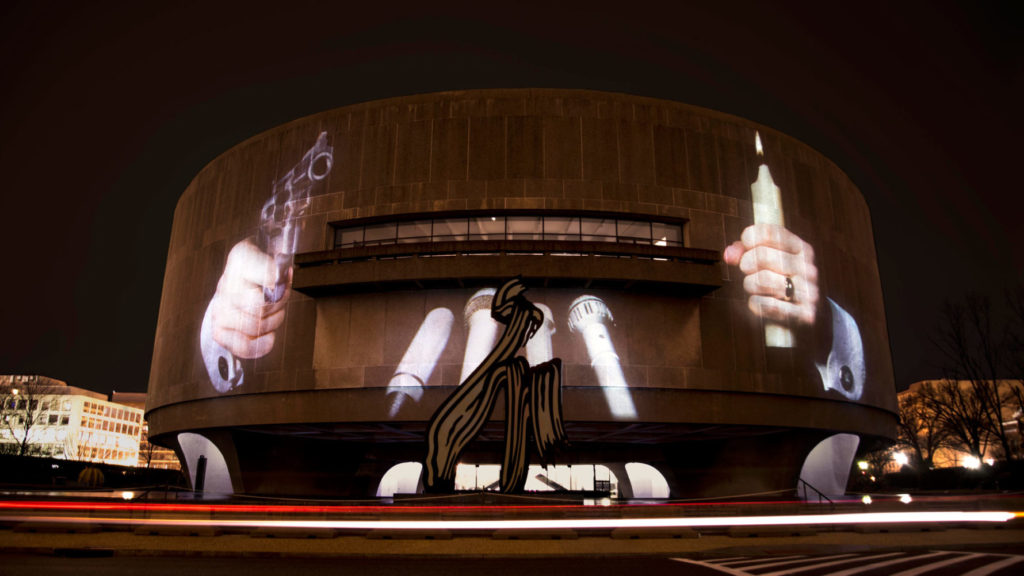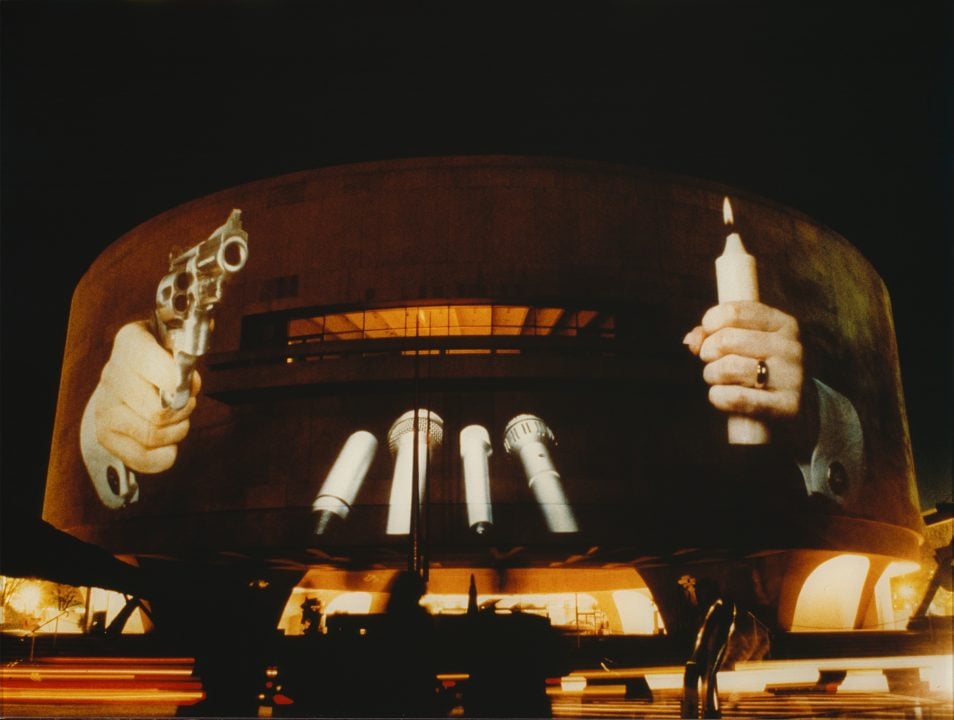Art & Exhibitions
Hirshhorn Museum Postpones Artist Krzysztof Wodiczko’s Gun Projection After Florida Shooting
But not everyone agrees it made the right decision.

But not everyone agrees it made the right decision.

Sarah Cascone

The Polish-born artist Krzysztof Wodiczko’s projection on the exterior of the Hirshhorn Museum and Sculpture Garden in Washington, DC, ended abruptly on Wednesday, February 14, just one day after it began.
The museum announced today that it will postpone the three-day projection of the 1988 work—which includes images of two hands, one gripping a revolver and the other a lit candle—following a shooting at a Florida school on Wednesday that left 17 people dead. It was the 30th mass shooting in the US so far this year, according to the Gun Violence Archive.
The decision was made “out of sensitivity to our community in DC and beyond,” the Hirshhorn’s director Melissa Chiu said in a statement. “Now is a time for mourning and reflection…. We remain committed to exhibiting this important work, which is still relevant today—30 years following its original showing.”
Although initial reports suggested the projection had been called off for good, a spokesperson clarified that the museum plans to restage the work at an unspecified later date within the run of the exhibition “Brand New: Art and Commodity in the 1980s,” which is on view until May 13. In the meantime, footage of the projection will be shown in the museum’s lobby alongside other works by the artist.

Krzysztof Wodiczko, Hirshhorn Museum, Washington, DC (1988/2018). Photo ©Krzysztof Wodiczko, courtesy of the Hirshhorn Museum and Sculpture Garden.
The Hirshhorn’s decision to remove the work, at least temporarily, illustrates the challenge museums face when presenting art that resonates with current events—and the anxiety that sometimes, if a work feels too relevant, it might cross the line into insensitivity.
“To me, the silence feels most respectful. In this case, not showing the projection shows respect and sensitivity to the people who suffer from this great tragedy,” Wodiczko said in a statement.
The Hirshhorn spokesperson did not immediately respond to an inquiry about whether the museum and the artist discussed in advance what might happen to the projection in the event of a mass shooting. The work went on view just two weeks after another shooting at a high school in Los Angeles.
When the museum first showed Wodiczko’s site-specific piece, titled Hirshhorn Museum, Washington, DC, on its facade 30 years ago, it was meant as a response to Reagan-era social policies and the heated presidential campaigns of George H. W. Bush and Michael Dukakis.
Ahead of the opening, Hirshhorn chief curator Stéphane Aquin seemed to acknowledge that the piece could be upsetting in the context of gun violence. “If this was restaged under the Obama administration after the Sandy Hook massacre, just by pure coincidence, we would have read a totally different story,” Aquin told the radio station WAMU.
Respectfully, this is a bad call. What point is there to creating if not to better our understanding? Certainly today's sad events makes the work's themes that much more urgent. Aren't these the times such art is made for?
— Gregory Pecked (@Gregory_Pecked) February 15, 2018
I understand the @hirshhorn is squeamish about projecting a gun image on its wall right now. But this is PRECISELY the right time to do it. We can't live forever in these cycles of shock, grief, acceptance and complacency. https://t.co/AUJxvCdOlt
— Philip Kennicott (@PhilipKennicott) February 15, 2018
On social media, some—including the Washington Post’s art critic, Phillip Kennicott—criticized the museum’s decision, arguing that Wodiczko’s work had only become more powerful and important immediately following the Florida tragedy. “With respect,” wrote Twitter user Todd Kimmelman, “the world needs this art installation now more than ever. Not exhibiting it only allows the evil in this world to triumph.”
For his part, Wodiczko told artnet News before the work’s debut that he wasn’t sure how it would be perceived today. “We shouldn’t force it to be relevant,” he said. “But maybe people will help this projection by generously trying to make use of it in today’s context.”